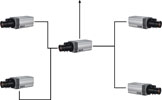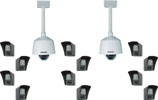

Most people consider James Bond-style surveillance technology to be both the ultimate video solution, and way beyond their affordability.
The arrival of the global economic crisis has collided with budgetary reality. The result is that the divide between big screen technology and real-life practicality has been widened.
“Inevitably in real life, James Bond-type applications tend to be downgraded to systems comprising generic IP (Internet protocol) cameras and a few DVRs (digital video recorders) because people are limited to purchasing what they can afford,” says Zane Greeff, technical director of Elvey Security Technologies. “In the worsening economy, security budgets are shrinking even though the need for security is growing.”
Greeff says he has seen this trend gathering momentum throughout the industry, characterised by the postponed or downright cancellation of projects as a result of budgetary concerns and economic uncertainty. The bottom line is that in today’s economy, few can afford to deploy the best cameras everywhere. “The reality is that users are downgrading camera functionality in order to maximise coverage within their budgets.”
Far from being a problem, however, the advent of blended video technology accommodates people’s need for good security at an affordable price.
“The blended video concept uses two radically different hardware systems capable of combining monitoring centre applications with self-monitored surveillance to enhance and complement each other. The result is ‘blended video’ which provides greater security by changing system architecture from many fixed generic cameras to many inexpensive remote sentries supporting a few high-definition surveillance cameras,” he explains.

Once notified of an intrusion, the surveillance cameras enable the owner to see what is happening and then coordinate a response in realtime. “In basic form, blended video can comprise a single megapixel PTZ (pan/tilt/zoom) camera with good optics mounted on a pole or rooftop. It would be configured to work with maybe say two dozen wireless remote sentries, ultimately providing high-definition surveillance and security over a large area.”
For this technology to be successful, installation is a critical element of the process, says Michael Brett, national sales manager of Elvey Security Technologies. “Because much of the blended video system is wireless, installation labour can end up costing less than 10% of the total project. That is versus 40% labour costs for a traditional surveillance system using wired cameras. The reason is that trenching and running cables outdoors to put the wired cameras on the perimeter or in remote locations is prohibitively expensive, hence the tightening up of labour costs.”
On their own, standard video cameras have historically provided poor intrusion detection capabilities, he continues. “Theoretically, cameras and DVRs are able to use changes in pixels or light to detect and notify but this capability has proven unreliable when used outdoors, tending to generate false alarms. And thunderstorms have been such a problem for pixel-motion-detection that many companies, in frustration, disable their cameras during storms. Adding expensive analytics helps, though it also pushes up the cost of the system and does not completely eliminate problems, especially outdoors. It is a fact that at many facilities, detection simply means staff watching a bank of video displays during business hours, after which DVRs take over. The after-hours video is then reviewed the following day.”
However, by deploying this technology in conjunction with the highest quality night vision pan/tilt/zoom cameras and lenses, it takes on a whole new credibility.
Explains Brett, “What these cameras do well is document the activity within their field of view and provide high-quality streaming video – the kind of James Bond-type technology that many people envisage when they think about surveillance. Though these cameras do not come cheap, the saving grace is that only a few are needed in a blended video system. Instead of trenching them, they are centrally located where they can be easily installed and maintained. The result is that security personnel now have a quality tool that allows them to view their entire site and arrive at response decisions based on reliable and clear imagery.”

The deployment of remote sentries in blended video overcomes the limitations of high-end PTZ cameras which cannot see everywhere at once and which do a poor job of actually detecting an intrusion, he notes further. “Blended video improves security by combining sophisticated cameras with less expensive video intrusion alarm systems able to detect and notify; that can be easily deployed to watch perimeters, entry points and blind spots not visible from the wired cameras.”
For detection, specialised outdoor PIR motion sensors can be effective but they cannot discriminate between humans and many animal species. This is one of their limitations on Brett’s list of potential problems. Others include that motion sensors require power and come with the same installation issues common to wired cameras. “For maximum effectiveness, visual verification is necessary to confirm that an intrusion does not turn out to be a stray dog,” he says. “Users want to know what is actually happening in order for them to be able to coordinate the appropriate response.”
The answer, he says, is cost-effective wireless motion viewers that detect and notify. “These self-powered remote sentries are able to incorporate outdoor PIR motion detection, digital cameras and infrared illuminators for night vision into a single unit. When they detect an intruder, they immediately send a 10-second video clip of the intrusion over the cell network to a monitoring station. At the central monitoring station, where operators are on duty 24/7, the video alarm from the remote sentries is then viewed and the user immediately notified of the incident.
“The operators communicate this information to the owner who can then use their sophisticated surveillance cameras to stream or document and coordinate their response,” he explains. “The central station does what it does best: notifying the owner or the police of an intrusion. What makes this application possible is affordable wireless remote sentries that can be installed anywhere without regard to power, trenching or cables. These remote sentries operate for years on a single set of batteries. Further, they can be placed up to 600 metres from their battery-powered communicator hub which transmits the 10-second long video alarm over the cell network to the central monitoring station.”
What makes the technology even more cost-effective is that one hub can support up to 24 remote sentries.
The sites that benefit most from blended video include construction sites. According to Greeff, building owners often require surveillance to monitor construction progress at the job site and then intrusion detection when the site is closed. That is because they are aware of the potential for subcontractors and employees to steal from the site.
“Installing enough wired cameras to protect against malicious employees who know the layout of the site, the location of valuables and where the cameras are placed, is extremely expensive,” he explains. “What is needed in these circumstances is a detect/notify system that can be reconfigured at the end of each workday and keep them guessing. With blended video, the remote sentries can be continuously redeployed. Because there are no wires, they are simply fastened where needed and moved as desired with a common installation as simple as two cameras on a pipe set in a bucket of concrete that can be moved where and when needed.”
For more information contact Kenny Chiu, marketing manager, Elvey Security Technologies, +27 (0)11 401 6700, [email protected]
| Tel: | +27 11 401 6700 |
| Email: | [email protected] |
| www: | www.elvey.co.za |
| Articles: | More information and articles about Elvey Security Technologies |

© Technews Publishing (Pty) Ltd. | All Rights Reserved.